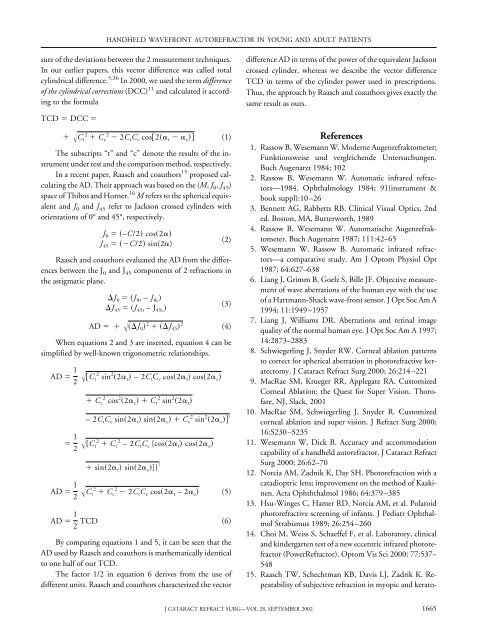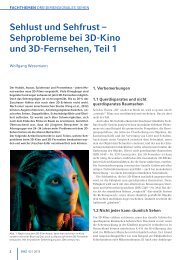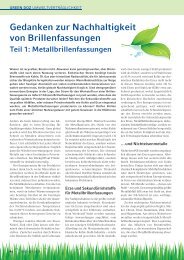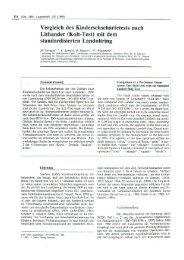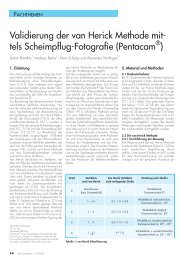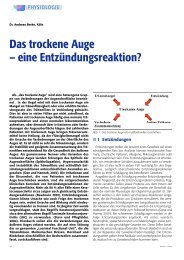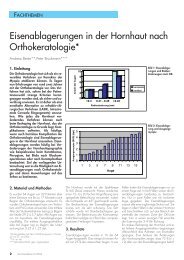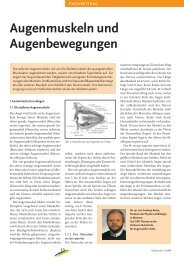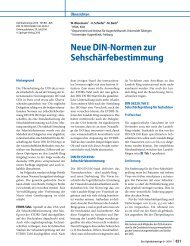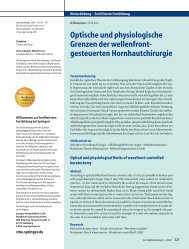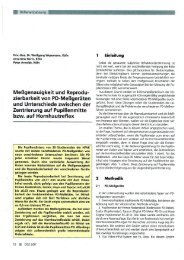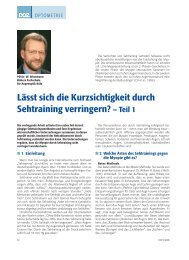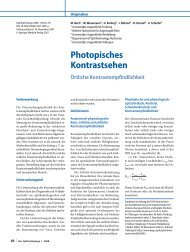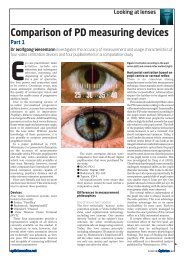Clinical evaluation of refraction using a handheld wavefront ...
Clinical evaluation of refraction using a handheld wavefront ...
Clinical evaluation of refraction using a handheld wavefront ...
Create successful ePaper yourself
Turn your PDF publications into a flip-book with our unique Google optimized e-Paper software.
sure <strong>of</strong> the deviations between the 2 measurement techniques.<br />
In our earlier papers, this vector difference was called total<br />
cylindrical difference. 5,36 In 2000, we used the term difference<br />
<strong>of</strong> the cylindrical corrections (DCC) 11 and calculated it according<br />
to the formula<br />
TCD DCC <br />
HANDHELD WAVEFRONT AUTOREFRACTOR IN YOUNG AND ADULT PATIENTS<br />
C t 2 Cc 2 2CtC c cos2 t c (1)<br />
The subscripts “t” and “c” denote the results <strong>of</strong> the instrument<br />
under test and the comparison method, respectively.<br />
In a recent paper, Raasch and coauthors 15 proposed calculating<br />
the AD. Their approach was based on the (M, J 0, J 45)<br />
space <strong>of</strong> Thibos and Horner. 16 M refers to the spherical equivalent<br />
and J 0 and J 45 refer to Jackson crossed cylinders with<br />
orientations <strong>of</strong> 0° and 45°, respectively.<br />
J 0 –C/2 cos2<br />
J 45 C/2 sin(2)<br />
Raasch and coauthors evaluated the AD from the differences<br />
between the J 0 and J 45 components <strong>of</strong> 2 <strong>refraction</strong>s in<br />
the astigmatic plane.<br />
J 0 J 0t – J 0c<br />
J 45 J 45t – J 45c<br />
(2)<br />
(3)<br />
AD J 0 2 J 45 2 (4)<br />
When equations 2 and 3 are inserted, equation 4 can be<br />
simplified by well-known trigonometric relationships.<br />
AD 1<br />
2 C t 2 sin 2 2 t – 2C tC c cos2 t) cos2 c<br />
C c 2 cos 2 2c C t 2 sin 2 2t<br />
– 2C tC c sin2 t) sin2 c C c 2 sin 2 2c<br />
1<br />
2 C t 2 C c 2 – 2CtC c [cos2 t cos2 c<br />
sin2 t sin2 c]}<br />
AD 1<br />
2 C t 2 C c 2 2CtC c cos2 t – 2 c (5)<br />
AD 1<br />
TCD (6)<br />
2<br />
By comparing equations 1 and 5, it can be seen that the<br />
AD used by Raasch and coauthors is mathematically identical<br />
to one half <strong>of</strong> our TCD.<br />
The factor 1/2 in equation 6 derives from the use <strong>of</strong><br />
different units. Raasch and coauthors characterized the vector<br />
difference AD in terms <strong>of</strong> the power <strong>of</strong> the equivalent Jackson<br />
crossed cylinder, whereas we describe the vector difference<br />
TCD in terms <strong>of</strong> the cylinder power used in prescriptions.<br />
Thus, the approach by Raasch and coauthors gives exactly the<br />
same result as ours.<br />
References<br />
1. Rassow B, Wesemann W. Moderne Augenrefraktometer;<br />
Funktionsweise und vergleichende Untersuchungen.<br />
Buch Augenarzt 1984; 102<br />
2. Rassow B, Wesemann W. Automatic infrared refractors—1984.<br />
Ophthalmology 1984; 91(instrument &<br />
book suppl):10–26<br />
3. Bennett AG, Rabbetts RB. <strong>Clinical</strong> Visual Optics, 2nd<br />
ed. Boston, MA, Butterworth, 1989<br />
4. Rassow B, Wesemann W. Automatische Augenrefraktometer.<br />
Buch Augenarzt 1987; 111:42–65<br />
5. Wesemann W, Rassow B. Automatic infrared refractors—a<br />
comparative study. Am J Optom Physiol Opt<br />
1987; 64:627–638<br />
6. Liang J, Grimm B, Goelz S, Bille JF. Objective measurement<br />
<strong>of</strong> wave aberrations <strong>of</strong> the human eye with the use<br />
<strong>of</strong> a Hartmann-Shack wave-front sensor. J Opt Soc Am A<br />
1994; 11:1949–1957<br />
7. Liang J, Williams DR. Aberrations and retinal image<br />
quality <strong>of</strong> the normal human eye. J Opt Soc Am A 1997;<br />
14:2873–2883<br />
8. Schwiegerling J, Snyder RW. Corneal ablation patterns<br />
to correct for spherical aberration in photorefractive keratectomy.<br />
J Cataract Refract Surg 2000; 26:214–221<br />
9. MacRae SM, Krueger RR, Applegate RA. Customized<br />
Corneal Ablation; the Quest for Super Vision. Thor<strong>of</strong>are,<br />
NJ, Slack, 2001<br />
10. MacRae SM, Schwiegerling J, Snyder R. Customized<br />
corneal ablation and super vision. J Refract Surg 2000;<br />
16:S230–S235<br />
11. Wesemann W, Dick B. Accuracy and accommodation<br />
capability <strong>of</strong> a <strong>handheld</strong> autorefractor. J Cataract Refract<br />
Surg 2000; 26:62–70<br />
12. Norcia AM, Zadnik K, Day SH. Photo<strong>refraction</strong> with a<br />
catadioptric lens; improvement on the method <strong>of</strong> Kaakinen.<br />
Acta Ophththalmol 1986; 64:379–385<br />
13. Hsu-Winges C, Hamer RD, Norcia AM, et al. Polaroid<br />
photorefractive screening <strong>of</strong> infants. J Pediatr Ophthalmol<br />
Strabismus 1989; 26:254–260<br />
14. Choi M, Weiss S, Schaeffel F, et al. Laboratory, clinical<br />
and kindergarten test <strong>of</strong> a new eccentric infrared photorefractor<br />
(PowerRefractor). Optom Vis Sci 2000; 77:537–<br />
548<br />
15. Raasch TW, Schechtman KB, Davis LJ, Zadrik K. Repeatability<br />
<strong>of</strong> subjective <strong>refraction</strong> in myopic and kerato-<br />
J CATARACT REFRACT SURG—VOL 28, SEPTEMBER 2002 1665


